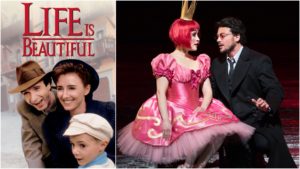
Opera Meets Film: Context Shifts How We Hear ‘Les Contes d’Hoffmann’ in Roberto Benigni’s ‘Life is Beautiful’
By David Salazar“Opera Meets Film” is a feature dedicated to exploring the way that opera has been employed in cinema. We will select a section or a film in its entirety, highlighting the impact that utilizing the operatic form or sections from an opera can alter our perception of a film that we are viewing. This week’s installment features Roberto Benigni’s “La Vita e bella.”
Context and the rule of two plays a central role through Roberto Benigni’s “La Vita e bella” or “Life is Beautiful.” It is divided quite evenly between two very contrasting sections, or stories; the first depicts Guido trying to woe his “Principessa” Dora, while the latter shows him trying to survive a Nazi prison camp. The first half focuses squarely on Guido and his growing romance with Dora while the latter on his relationship with his son Giosuè.
And we hear Offenbach’s barcarole from “Les Contes d’Hoffmann” on two occasions, one in each half of the film and both pertaining to his relationship with Dora.
Flowering Love
The first such instance of the famed passage comes at the Opera House in Venice where both characters attend. Dora goes with her fiancée while Guido heads over in search of her. While he is in the orchestra section, she is in a box above him, the distance between the two future lovers a prominent aspect of the cinematography. Far off onstage, we see and hear the voices of Nicklausse and Antonia intone the famed words “Belle nuit, ô nuit d’amour,” which Guido later repeats.
Guido’s main objective in this moment, amidst a theater of other opera goers is to get his beloved to make eye contact with him. He even ushers in a “magic trick” based on Schopenhauer’s philosophy that repeating words have power. We get a rather comic moment when a woman beside him turns in his direction and he notes that he can only hear out of his right ear.
And while this humor appears in the scene, the crux really comes down to the connection between these characters. We focus on a tight closeup of Dora as she looks at the stage and then ever so slowly turns to make eye contact with Guido. It is a quick and brief moment, but it furthers their connection, becoming, to that point, the most intimate moment between them, their eyes meeting. We have felt the flirtation between them earlier in the film, but it is here, with the backdrop of Offenbach’s alluring melody for two voices, that we feel that they might really be connected on a deeper level. It is almost a turning point from where there is no escape.
Right after this, the two enjoy a night together that climaxes in Guido expressing his love for Dora. As if to remind us of the association of their love with the “Hoffmann” duet, Guido starts to sing it out loud as she runs down the street. It has been seared into our subconscious, becoming, in a way, their love motif.
One Final Moment
But we don’t hear it again until late in the film. The two are now separated yet again with Dora on one side of the concentration camp and Guido and his son on another. Guido is serving a banquet and suddenly comes upon a phonograph, the current LP finished. As he searches through another connection of LP recordings, he finds something and puts it on, shifting the megaphone toward the window so that the music can play out into the camp.
Sure enough, it is that same duet from “Les Contes d’Hoffmann,” and once again, Guido’s aim is to connect with his beloved. At the opera, he was hoping that she would actually shift her attention away from the stage and look in his direction, the music actually in direct opposition to his aims.
But here, the music is that point of connection between the two and sure enough Dora responds, hearing the music clearly. The piece immediately reminds us of its first and only other association, juxtaposing those days of innocence with the current tragedy experienced by the character and creates a massive rush of emotion for the viewer.
Context is Everything
On an immediate level, we feel the connection between the two lovers, and like them feel the desire to see them together. Reminding us of that first scene, in some ways, the music gives us hope of them overcoming the obstacles separating them to get back together, just as they did in the first half of the film.
And yet, with the view we have of history and our understanding of this particular moment, we are filled with even more melancholy and fear, pondering whether this might be their final true moment of connection. The piece, which had a tinge of hope in its first iteration, suddenly takes on a different complexion, almost saddening and hopeless.
Context proves to be key in how we react to the same exact piece of music.
Ultimately this is what this particular film does so well – particularly with its central figure, always so joyful and optimistic. We see him retain that character throughout, and yet we can’t interpret it in the same manner when the context and danger surrounding him shifts.
So goes with “Belle nuit, ô nuit d’amour!”


